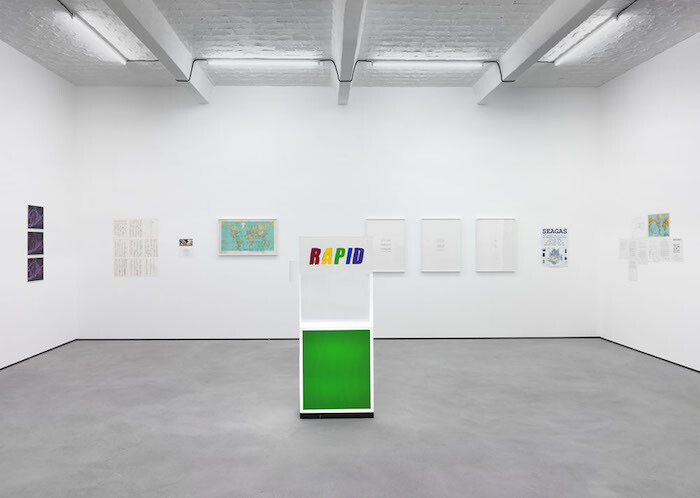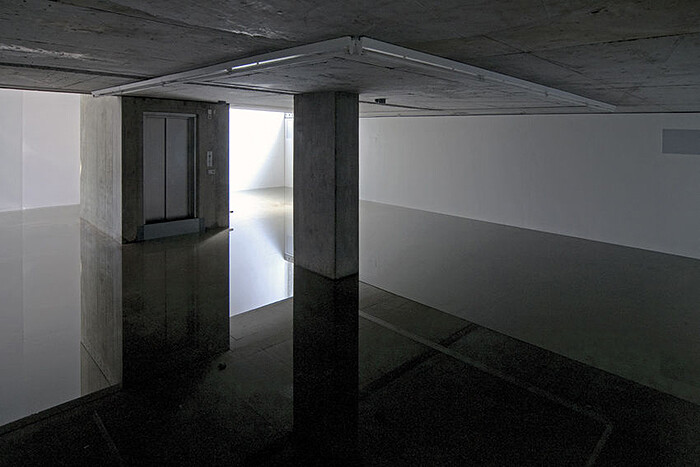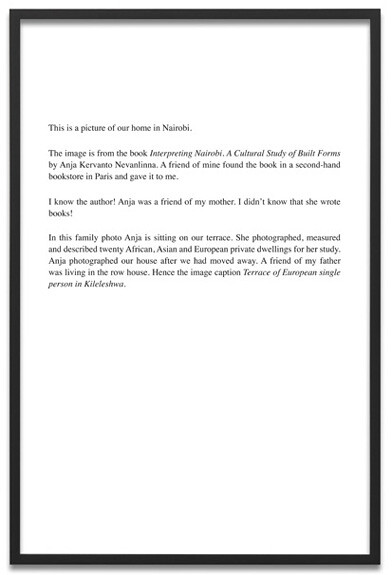Categories
Subjects
Authors
Artists
Venues
Locations
Calendar
Filter
Done
December 16, 2015 – Review
Peter Fend’s “to be built”
Elvia Wilk

At first I had the feeling I was missing something when I encountered the documentation of unbuilt works by Peter Fend at his show “to be built” at Galerie Barbara Weiss, organized in collaboration with the project space Oracle. The drawings, prints, collages, and documents on display, mostly from the first 20 years of Fend’s practice, are billed as projects meant “to be built,” but if they’re really instructions, they’re hard to follow. For example, Delancey Street goes to the Sea, II, III, and IV, a series of quite beautiful collages from 1979, declares “CON ED / NO MAJOR GAS LINES DOWNTOWN,” with text overlaid on an aerial shot of lower Manhattan, followed by “SEA GAS INSTEAD,” the proposed solution. Red and orange lines drawn over the image demonstrate how waste pipes could be extended from Delancey Street across Brooklyn and into Jamaica Bay, and sea gas could be sent back again. Sounds like a good idea. But how, exactly, would sea gas get made from the waste? Could you really lay a pipeline in a straight shot across an entire borough? Who would finance the project? Wait, what’s sea gas again?
Fend is probably best known for his founding role …
June 13, 2014 – Review
Geta Brătescu’s “Atelier Continuu”
Ana Ofak

Benno von Archimboldi—the mythical writer in Roberto Bolaño’s 2004 novel 2666—used to draw algae as a child. The meticulousness with which the boy captured the greenish pulp he encountered on his prohibited dives in muddy waters extended into his writing as a grown man. None of this is known to the group of literary critics who devote their lives to Archimboldi. They roam the world in search of snippets of information that might enrich their meager outputs. No institution will ever come to help them. The fictive search mirrors contemporary aesthetic politics in an eerie way. After post-communism fell ill, when ideological etiquettes no longer fit Eastern Europe, the art world’s interest in the region’s manifold visual territories has grown in inverse proportion to the understanding of its context. Due to the homogenization of taste, Eastern Europe appears like a treasure trove, set apart from the corporate consolidation of aesthetics. One wonders if all of its Archimboldis will ever receive the attention they deserve.
Among the artists from Romania, Geta Brătescu (b.1926) is the grande dame of Conceptualism. Her work has established a discreet, object-bound, almost poetic presence in the country and elsewhere. It has been in the spotlight for several …
September 18, 2012 – Review
Mai-Thu Perret at Galerie Barbara Weiss, and Berlin Art Week Highlights
Ana Teixeira Pinto

Brought to you by Kulturprojekte Berlin, the producers of last year’s “based in Berlin” survey, Berlin Art Week is a mayoral initiative funded by the Senate Chancellery for Economics and the Senate Chancellery for Cultural Affairs, which seeks to make up for the loss of the ill-fated Art Forum Berlin by labeling the week around abc (Art Berlin Contemporary) as if some sort of extra cultural activity is actually taking place. Most of the city’s institutions are listed on the Art Week’s website, but for anyone who lives in the city, it feels rather paltry to see announcements featuring shows which opened weeks, even months ago, re-branded to sound brand new. It would seem that pretty much everything else in the city, which is being radically redesigned for the benefit of the leisure classes, is being marketed to the occasional tourist or the potential investor.
But to begin rather with a nuanced comment on the city as a haven for real estate speculation, we recommend seeing how architect Arno Brandlhuber flooded the basement of his own signature building on Brunnenstrasse for the show at KOW, “Im Archipel,” which runs concurrently at n.b.k. (Neuer Berliner Kunstverein), in one of the few de …
December 14, 2011 – Review
Laura Horelli’s “The Terrace”
John Beeson

From the first, Laura Horelli’s exhibition “The Terrace” is a movement backwards; a complex history is laid out for us to enter and reconstruct. Along the wall leading away from the gallery’s entrance is a series of six images and texts entitled Terrace of European Single Person in Kileleshwa (2011), which reveal information progressively. The first photograph depicts a young girl entering from a terrace, where a woman sits on a wicker chair before a backdrop of exotic plants. To the left of that photograph is a text describing a house topographically, designating spaces as private, public, or those used by the domestic staff. To the left of that is the house’s architectural floor plan. Next is a black-and-white illustration from a book depicting that same terrace from the first photograph, but as seen from the garden beyond it. Then we see the original version of that photo in full color. Lastly, we encounter a text revealing that everything we have just seen pertains to the Finnish artist’s childhood home in Nairobi, Kenya. The series appears to have been developed from a method at once inquisitive and analytical, based on personal understanding as well as empirical research.
Such is the variable …
